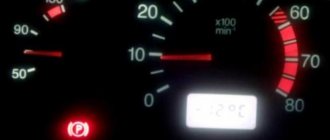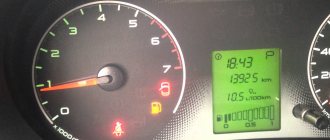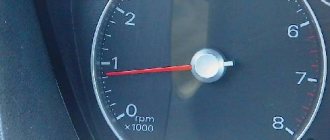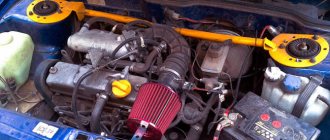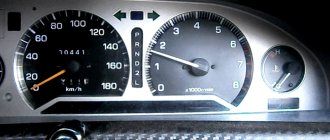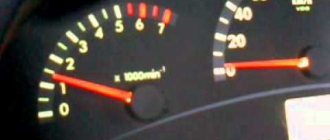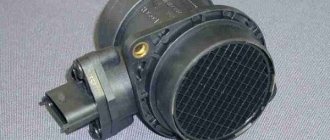In order not to be a complete layman, even as a novice car enthusiast, we will look at this topic in more detail using the example of VAZ cars - the latest models of this amazing vehicle manufacturer. As they say, let's look under the hood, listen, smell, look and decide what can be done with such a domestic miracle of technology as Priora or Kalina.
The beginning of problems
If you unexpectedly discover that the idle speed in your car is floating, not only do you not need to panic, but generally be nervous. This nasty thing can occur both on cars with a carburetor engine and on models with an injection engine, and most importantly, sometimes even decent foreign cars, not to mention domestic models, do not avoid this fate.
The only difference is in the fuel injection system and, accordingly, in the methods of eliminating this trivial nuisance. But, since we decided to consider the problem from the point of view of modern Priora and/or Kalina, then we will have to evaluate the injection version of the engine with the so-called electronic fuel injection.
So why is this happening
Root causes of problems
The most common situations in which floating speeds occur:
- Cars with a built-in electronic fuel injection system suffer from such problems much more often than others. And this happens due to the constant suction of excess air, the volume of which still increases, which leads to the formation of a malfunction. The sensor responsible for gasoline injection simultaneously calculates the volume of air entering the cylinders. Based on these and some other indicators of the sensors, the electronic unit opens the electromagnetic injection valves for some time. It follows from this that when there is an excessive amount of air in them, the sensor, which is responsible for the position of the throttle valve, shows the driver that the task assigned to the system is impossible - the check light is on. During this, the temperature sensor indicates that the engine is exiting the warm-up mode. This indicates that it needs less fuel. Just at such a moment, floating speed appears in the car at idle, because the electronic unit does not understand what to do with the accumulated excess air in the system.
- This reason also partially relates to air suction and occurs mainly on 16-valve engines. The main place where air leaks still occur is the gluing contour of the receiver elements. Even minor damage to this area will lead to unstable operation of the motor.
- Constant jamming also easily becomes a reason for the occurrence of floating speed. It occurs in the crankcase ventilation valve. Therefore, if the reason is precisely this phenomenon, the systematic operation of the automatic power regulation sensor is disrupted. As a result, the same sensor signals instability of the engine. In a faulty state, the speed ranges from 1,300 to 900 per minute.
- In models with a carburetor engine, floating speed occurs due to a violation of the control of the servomotor. To correct this problem, simply unscrew the adjustment bolts in the area of the servomotor where the sensor points to the loose drive.
- Low pressure in the fuel system causes the same problems.
- Breakdowns in the ignition system are sometimes also classified as causes of floating speed. The problem is primarily related to high-voltage wires and spark plugs. But only with a visual inspection will it be possible to understand whether they are really the problem.
- A breakdown of the IAC (idle air regulator) causes floating speeds, because it is responsible for their initial stability. The element is inexpensive and can be replaced, so there may not be any significant problems with this.
- The electronic gas pedal has a lot of disadvantages, especially if tuning the car is only in the process, but the car is actively used. Floating speed is a fairly common occurrence in such a situation.
The speed can fluctuate not only when the engine is cold, but also when the engine is hot. It all depends on the cause of this phenomenon.
So what to do if floating speeds appear with enviable frequency and significantly interfere with the quiet use of the vehicle?
How it happens in reality
You leave the house, get into the car, start the engine and then bam! – the idle speed begins to jump like mad, then rising to 3 (or even 4 thousand), then dropping to a thousand revolutions per minute or less, until the car finally stalls.
However, the situation can develop completely differently: sometimes these surges can just as suddenly disappear after a short warm-up of the engine, but it also happens the other way around - you’ve been driving for a long time, you stop at a traffic light, for example, and then pandemonium begins.
Step-by-step replacement instructions
- Using a Phillips screwdriver, remove the two screws securing the idle air control valve to the throttle body.
- Removing the idle air control
- Using an ohmmeter we measure the resistance between the terminals of the windings.
- Using a caliper with a depth gauge, we measure the protrusion of the new valve needle.
- If the valve protrusion is more than 23 mm, recess the valve into the body as follows:
- We connect the positive terminal of the battery with a wire to terminal D of the regulator (the connection of the wire to the terminal must be insulated);
- With the bare end of the wire connected to the negative terminal of the battery, briefly touch terminal C of the harness block. Since the valve moves very slowly, we touch it repeatedly, reproducing the operation of a switching power supply.
- Visually check the condition of the o-ring. We replace the damaged ring.
Install the regulator in reverse order
What's the matter
There may be several reasons for this disgusting and inappropriate behavior. We will list all possible situations when the idle speed fluctuates.
- The electronic control unit of the car (on-board computer), called the “brains,” has “gone crazy.” Simply put, the system caught a glitch.
- The throttle position sensor is broken.
- The temperature sensor brazenly “lies”, showing that the engine has long warmed up and is ready for maximum load, which means it no longer requires increased fuel supply.
- If there are increased idle speeds, then it is likely that the crankcase ventilation valve has closed.
Operating principle of IAC
When the engine is running without increasing speed, that is, at idle, a minimum volume of air enters the combustion chambers of the cylinders. This occurs regardless of the throttle valve being in the closed position. The volume of intake air consumed is monitored and measured by the MAF (mass air flow sensor), which sends data to the ECU.
Based on the information received, the control unit supplies the required amount of fuel to the cylinders through the injectors. At the same time, the controller monitors the crankshaft speed using its position sensor (DPKV). According to the data obtained, the IAC needle opens or closes, controlling the air supply past the throttle valve, which at this stage is not involved in the operation of the engine.
If the engine has not yet reached the set temperature, the controller uses the IAC to increase the air supply, increasing the crankshaft speed to warm up the power unit faster. Thanks to this mode, the car can start moving almost immediately, without the need to reach operating temperatures.
Technically, the IAC is not a sensor, it is an actuator, so the controller cannot diagnose its malfunction. This means that the “Check Engine” icon will not light up on the instrument panel if the regulator breaks down. In their symptoms, IAC malfunctions are similar to TPS (throttle position sensor) malfunctions. But in the case of the latter, the icon will definitely light up, indicating engine problems.
How to behave and what to do
If you have never touched anything in the engine and are desperately afraid to do it, then the easiest way out will still be a trip to the service center, where the mechanics will “find” a dozen reasons to rip off a good chunk of your spare money. However, if you have a basic desire, you can do everything yourself, thereby saving your hard-earned money.
- Check the speed adjustment screw and simply tighten it if necessary. This way you will close the hole through which the air escapes.
- Using regular pliers, pinch the fuel pipes one by one. This way you can determine which one has a crack or even a hole.
- Check the crankcase vent valve for opening/closing. It is quite possible that it also does not work stably.
- Be sure to look at the operation of the throttle valve. If it doesn't open on time or doesn't close on time, then naturally the problem is here.
- Finally, having not found a single violation in the first four points, you can be sure that the cause of the floating speed was the “lying” on-board computer, that is, the “brains” of the car and the error can be eliminated either by having a special tester on hand, or after all by visiting a repair shop, where the error will be removed.
Recommendations
In addition to the above, don’t be lazy and also check the spark plugs, the wires going to them and the distributor. This does not greatly affect the speed, but in total it can bring a positive result.
In the morning at -1, the revs on the tachometer are first 500, and after 1-2-3 seconds the warm-up speed is 1100. I changed the wires, changed the idle, changed the TPS, changed the spark plugs, changed the coil, called with a multimeter. I checked the DMRV readings 0.98. I installed a new air filter. I changed the idle sensor, removed the throttle, it was clean.
And still the relay makes one click and from 500 it is set to 1100, as it warms up everything is fine, then it is set to 900 and it starts without any hang-ups. I don’t know where to dig, what to look for?
The firmware has not changed, original Bosch. I don’t really know what the numbers are, just if you can write something. I’m already thinking, maybe there’s something wrong with the firmware during a cold start? So the main thing is that it warms up for 1 minute, I turn it off, start it again, this is no longer the case. It’s just some kind of trouble, and if the frost hits -30, it will completely shut down, well, in general, such things.
Idle speed regulator Lada Kalina and its device
- a housing in which a stepper motor is located with two windings independent of each other, rotor supports (rear and front);
- valve shut-off needle and spring;
- power connector.
3 main functions of the controller
1. In addition to maintaining the required engine speed, the device ensures its proper operation under cold start conditions (warming up at sub-zero air temperatures). In this case, the regulator provides higher engine speeds until the latter warms up to operating temperature. 2. The second important function that many drivers don’t even think about is the speed maintenance mode without pressing the gas pedal. In other words, ensuring the engine operates at idle speed is the merit of the IAC. 3. The third and very important purpose of the product is to ensure the creation of an air-fuel mixture of the required concentration and saturation. This feature has a positive effect on final fuel consumption and smooth engine operation.
Possible faults
RPM fluctuates at idle
After talking with car owners, as well as with car service technicians, we can conclude that floating engine speed on a car is a fairly common effect. As a result, the car may begin to twitch when starting off. Most car enthusiasts assure that this malfunction appears during warranty service.
This may be due to many factors.
Let's consider the main reasons for the occurrence of floating engine speeds:
- Fuel system malfunction.
Malfunction of fuel system elements
Problems with the ignition switch or wiring
Troubleshooting ECU errors
Low-quality gasoline directly affects the operation of the power unit
All these reasons contribute to the appearance of such an effect. The most common reason is problems with injection.
Treatment methods
Before moving on to correcting the problem, it is worth noting that floating speed is just the beginning, since untimely elimination of the malfunction can lead to a “start-stall” effect.
So, let's consider the sequence of actions to eliminate the causes of floating engine speed.
Fuel system
As practice and experience show, floating speeds appear in the event of an uneven supply of fuel to the combustion chambers, or a constant change in the amount of the fuel mixture.
conclusions
Floating idle speed of the Lada Kalina engine can cause other, more serious problems to appear. So, if such an effect occurs, it is necessary to find the cause and eliminate it. If you can’t do it yourself, you need to contact a car service, where they will quickly find and fix the problem. Repeatedly, due to the constant effect of floating speed, car owners have had to change the electronic control unit.
Many car enthusiasts have come across the concept of floating engine idle speed. For the Lada Kalina, as practice shows, this is a common malfunction that can be fixed with your own hands, but sometimes you will need to use a car service.
FakeHeader
Comments 21
When the rpm drops to 600 - is it once every about 30 seconds or constantly?
Then it's definitely not an adsorber. If the AIR fitting of the canister is clogged, then when the canister valve is opened, air will be driven out of the tank (the speed will drop exactly once every 30 seconds), but the canister works for no more than 3-4 seconds, after which it turns on again only after about 20-30 seconds. You can safely cross it off the list.
I’m having this problem myself now, but I have it once every 20-30 seconds, and that’s exactly when the adsorber valve opens for purge. I disconnected the hose from the adsorber going to the valve, the speed stopped falling. It seems to me that this is exactly the situation when the AIR on the adsorber is clogged with dirt or coal. The valve opens and, instead of fresh air, draws gasoline vapor directly from the tank, then the rpm drops to 500 and a sharp rise to 1200. The valve closes and everything is fine until the next opening. =(
And what should I do with it so that the revs don’t fluctuate?
When the rpm drops to 600 - is it once every about 30 seconds or constantly?
And so on constantly in neutral until you turn it off. The voltage in the onboard after a drop in rpm also drops to 13.6 and rises with the rpm
The revs are fluctuating - first of all, look for air leaks. Whistling occurs more often. Possible places: a rubber plug on the intake manifold, a stuck absorber valve, a vacuum booster, stiffened injector rings and intake manifold seals at the joints. Everything is checked by clamping the pipes or temporarily replacing them with plugs. That is, for example, you pull out the vacuum pipe from the manifold and stupidly plug it with your finger, etc.
I have the same problem, but only in winter you stop at a traffic light and the revs start to float, also e-gas, the check does not light up, I changed the spark plugs, it helped, the factory spark plugs lasted 3000 km, new ones for another 4000 km, then I installed NGK, so far it’s ok
The main reasons for the reduction in engine power
Crankshaft position sensor malfunction
There are situations when the DCPV untimely sends a control command to supply the air-fuel mixture. As a result, the power of the power unit drops before our eyes. The main cause of the failure is the shift of the toothed star relative to the pulley and the delamination of the damper. In such a situation, it is necessary to carefully inspect the damper and replace it.
Increasing (decreasing) the gap between the spark plug electrodes
During operation, due to strong temperature effects, the distance between the electrodes of the spark plug may decrease or increase. To exclude or confirm your suspicion, you need to check the size of the gaps using a round feeler gauge. If the distance is less or more than acceptable, you need to make an adjustment by bending the side of the electrode or replace the spark plug. As for the optimal spark gap distance, it can be different (depending on the type of spark plug) - 0.7-1.0 mm.
Replacing the air flow sensor
The replacement procedure is as follows:
- First you need to loosen the clamp that secures the air duct, for this you use a Phillips-head screwdriver. The pipe itself can be dismantled.
- Disconnect the power connector from the regulator; to do this, simply press the latch at the bottom and pull the plug itself to the side.
- Next, using 10mm wrenches, you need to unscrew the two bolts. It may be difficult at this stage, so you can use a ratchet to unscrew the bolts quickly.
- The regulator can then be moved to the side and removed.
- The installation procedure is carried out in reverse order.
Functional features
The main purpose of the sensor discussed here in Lada Kalina is to measure the main parameters in the intake system and adjust the speed. This is done by sending pulses to the engine control module, which, based on the data received, adjusts the volume of injected fuel.
Due to the fact that the specified idle speed regulator acts as an actuator, determining its failure is a very difficult task. This is due to the lack of a useful self-diagnosis function in the Lada Kalina.
The device is designed to control the volumes of air that are directed through the intake tract into the combustion chambers of the engine. Here, the air mass (also measured by the mass air flow sensor) enters through a special channel, bypassing the throttle valve, which is closed in idle speed mode.
This idle speed regulator is involved in warming up the 8-valve engine, ensuring that the unit reaches its operating temperature in a timely manner.
When the ignition is turned on, a rod “crawls out” from the regulator and reaches a specially designed hole. This is called the initial position of the sensor.
Next, we outline the primary functions of this device:
- adjusting the optimal air mass;
- participation in warming up the engine 8 valves;
- determination and adjustment of the number of revolutions.
Fuel pump
If the car operates normally at idle, but as the latter increases, it immediately begins to stall, then the problem with the highest degree of probability will be reduced to a malfunction of the fuel pump. This all happens because no one supplies fuel to the carburetor. One of the most unpleasant situations.
What to do: repair, or even better, completely replace the fuel pump.
